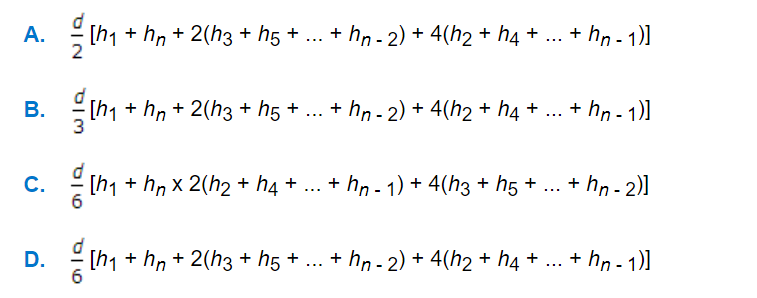Question

a.
A
b.
B
c.
C
d.
D
Posted under Civil Engineering
Interact with the Community - Share Your Thoughts
Uncertain About the Answer? Seek Clarification Here.
Understand the Explanation? Include it Here.
Q. If d is the distance between equidistant odd ordinates, the Simpson's rule for the areas, is
Similar Questions
Explore Relevant Multiple Choice Questions (MCQs)
Q. To set out a parallel from a given inaccessible point to a given line AB, the following observations and made
Distance AB and angle PAM = a and angle PBA = b are measured where M is a point on the line BA produced. The perpendicular to the desired parallel line from A and B are :
View solution
Q. The distance between the point of intersection of an up grade + g1% and downgrade g2% and the highest point of the vertical curve of length L, is
View solution
Q. If V is the speed of a locomotive in km per hour, g is the acceleration due to gravity, G is the distance between running faces of the rails and R is the radius of the circular curve, the required super elevation is
View solution
Q. The ratio of the radius and apex distance of a curve deflecting through Δ°, is
View solution
Q. α, β are the horizontal angles measured at the ends of a base line AB to a hill top whose angle of elevation from station A is θ°. The height of the hill top above the trunnion axis of the theodolite station, is
View solution
Q. Correct distance obtained by an erroneous chain is:
View solution
Q. If h is the difference in height between end points of a chain of length l, the required slope correction is
View solution
Q. The conventional sign shown in below figure represents a
View solution
Q. If L is the specified length of a tape, L1 its actual length and S the measured distance, then, the true distance is given by the formula,
View solution
Q. Accidental or compensating errors of length L are proportional to
View solution
Q. The following is the conventional sign of
View solution
Q. If α and β be the elevations of two objects A and B respectively, θ be the angle observed by a sextant. The correct horizontal angle is
View solution
Q. Following is a conventional sign of
View solution
Q. If Δ is the angle of deflection of a simple curve of radius R, the length of the curve is :
View solution
Q. The conventional sign shown in below figure represents a
View solution
Q. If Δ is the angle of deflection of a simple curve of radius R, the distance between the mid-point of the curve and long chord, is
View solution
Q. If F is the pull applied at the ends of tape in kg, l is the length of tape between end marks in metres, w is the weight of the tape in kg per metre run, then sag correction
View solution
Q. Correction per chain length of 100 links along a slope of α° is
View solution
Q. The Trapezoidal rule of volumes V of an embankment divided into a number of sections equidistant D, is given by
View solution
Q. Correction per chain length of 100 links along a slope of α radians, is
View solution
Recommended Subjects
Are you eager to expand your knowledge beyond Civil Engineering? We've handpicked a range of related categories that you might find intriguing.
Click on the categories below to discover a wealth of MCQs and enrich your understanding of various subjects. Happy exploring!








